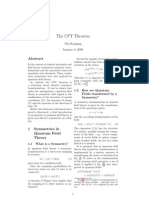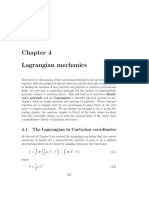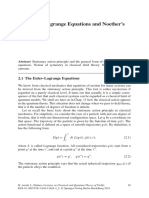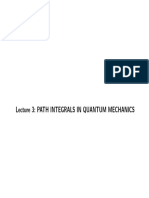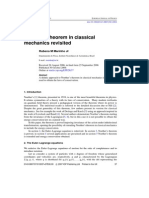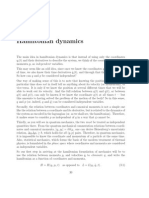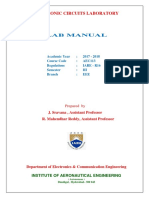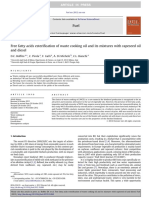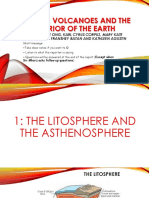Ch01 PDF
Ch01 PDF
Uploaded by
phooolCopyright:
Available Formats
Ch01 PDF
Ch01 PDF
Uploaded by
phooolOriginal Description:
Original Title
Copyright
Available Formats
Share this document
Did you find this document useful?
Is this content inappropriate?
Copyright:
Available Formats
Ch01 PDF
Ch01 PDF
Uploaded by
phooolCopyright:
Available Formats
1
Classical eld theory
Field theory is one of the cornerstones of classical physics. The most notable
examples of classical elds are the force elds that one encounters in the de-
scription of gravitational and electromagnetic phenomena. These elds are
caused by the presence of masses and electric charges, respectively. In this
chapter we present a framework for classical eld theory, which is known as
the Lagrangian formulation. In this formulation the dynamics of a system is
described by a single function, the Lagrangian. Via a variational principle the
Lagrangian yields the equations of motion which govern the time evolution of
that system, so it is a useful mnemonic for summarizing a theory in a concise
form. The use of a variational principle to express the equations of classi-
cal physics is very old. Fermats principle in optics (1657) and Maupertuis
principle in mechanics (1744) are famous examples.
Apart from its conciseness and its mathematical elegance we mention two
important reasons why the Lagrangian formulation is so convenient in eld
theory. The rst one is that the Lagrangian, or rather the integral of the
Lagrangian density over space and time, should be invariant under all sym-
metries of the theory in question. This aspect of the Lagrangian formulation
makes it rather attractive for relativistic theories, because it allows one to
treat space and time on an equal footing from the very beginning, in contrast
to other approaches where one aims directly for a description of the time evo-
lution. The second advantage of the Lagrangian formulation, emphasized by
Dirac and elaborated on by Feynman, is that it plays a natural role in the
path integral formulation of quantum mechanics. It turns out that the evo-
lution operator for a quantum-mechanical wave function can be expressed as
a sum over all paths with xed endpoints in space-time weighted by a phase
factor that depends only on the Lagrangian integrated along the path.
1.1. The Lagrangian and Hamiltons principle
In order to introduce the basic concepts of the Lagrangian formulation it is
convenient to start from classical mechanics. Consider, for example, a sys-
tem of N particles of equal mass. Its classical motion is described in terms of
coordinates q
i
(t) (i = 1, . . . , 3N) which are functions of time. These 3N coor-
dinates describe a trajectory in space-time; one determines the velocities by
q
i
(t) = dq
i
(t)/dt and the accelerations by q
i
(t) = d
2
q
i
(t)/dt
2
. The equation
1
2 Classical eld theory [Ch.1
of motion in classical mechanics, which determines the acceleration in terms
of the force applied to these particles, or acting between these particles, is
Newtons law,
m q
i
(t) = F
i
(t) . (1.1)
We will restrict ourselves to the case in which the forces are derivable from a
potential V (q
i
) according to
F
i
=
d
dq
i
V . (1.2)
The forces are then called conservative.
Given the value of the coordinates q
i
and the velocities q
i
at a given time,
Newtons law allows us to construct the full trajectory in terms of the coor-
dinate functions q
i
(t). Alternatively, one can uniquely determine a trajectory
by specifying the value of the coordinates q
i
(t) at two dierent times, say t
l
and t
2
, i.e.
q
i1
= q
i
(t
1
) , q
i2
= q
i
(t
2
) . (1.3)
Then, among the innite variety of ways in which this physical system can
move from q
i1
to q
i2
, Newtons equation uniquely picks out one particular
trajectory. Now suppose that one assigns a real number to each of the pos-
sible trajectories between q
i1
and q
i2
. An object that assigns a number to a
function is called a functional, and we denote it here by S[q
i
(t)]. It turns
out that it is possible to dene a functional, called the action, such that the
number assigned to the physical path between q
i1
and q
i2
that is prescribed
by Newtons law corresponds to a stationary value (usually a minimum) of
this functional. There are thus two alternative approaches to the problem at
hand which lead to equivalent results. One is to simply solve Newtons equa-
tion (1.1); the other one is to determine the trajectory for which the action
functional that we are about to dene acquires a minimum (see g. 1.1). The
latter formulation thus amounts to solving a variational principle.
In order to present the variational principle we rst dene the action func-
tional S[q
i
(t)]. It is written as the time integral of the Lagrangian L(q
i
, q
i
),
which is usually a function of coordinates and velocities, i.e.
S[q
i
(t)] =
_
t
2
t
1
dt L(q
i
(t), q
i
(t)) . (1.4)
Note that (1.4) is indeed a functional because it assigns a number to every
given trajectory described by q
i
(t). The variational principle now states that
the trajectory that is followed by the system is the one for which S[q
i
(t)] has
an extremum. Hence
S[q
i
(t)] = 0 , (1.5)
1.1] The Lagrangian and Hamiltons principle 3
q(t)
t
t
2
t
1
q
2
q
1
Figure 1.1: Various paths from q
1
to q
2
. The thick line indicates the path for
which the action is stationary. This path satises the equation of motion.
for all trajectories q
i
(t) that have the required endpoints at t = t
1
and t = t
2
(cf. 1.3). This variational principle is known as Hamiltons principle.
Irrespective of the precise form of the Lagrangian, it can be shown that so-
lutions of Hamiltons principle satisfy the so-called Euler-Lagrange equations,
also called the equations of motion,
d
dt
_
L
q
i
_
L
q
i
= 0 . (1.6)
Usually (1.6) is a second-order dierential equation which can be solved for the
coordinates q
i
(t). Its solutions are unique provided we impose certain bound-
ary conditions, such as the specication of all the coordinates and velocities
at one instant in time, or of all the coordinates at two dierent times t
1
and
t
2
as we did in (1.3).
Before establishing the equivalence of (1.5) and (1.6) we rst elucidate the
meaning of (1.6). Consider the motion of a single particle in a potential. The
Lagrangian is the dierence between the kinetic energy T =
1
2
m q
2
and the
potential energy V (q), i.e.
L =
1
2
m q
2
V (q) , (1.7)
so the Euler-Lagrange equation yields
m q +
V (q)
q
= m q F = 0 ,
4 Classical eld theory [Ch.1
which is just Newtons law (1.1). For a free particle (V (q) = 0) this equation
can easily be solved. If the particle is located at q
1
at t = t
1
and at q
2
at
t = t
2
, it moves according to
q(t) = q
1
t t
2
t
1
t
2
q
2
t t
1
t
1
t
2
. (1.8)
This result can be substituted into the action corresponding to the Lagrangian
L =
1
2
m q
2
.
One then nds
S[q(t)] =
m
2(t
2
t
1
)
(q
2
q
1
)
2
, (1.9)
which depends only on the boundary values of the trajectory. According to
Hamiltons principle all other trajectories from q
1
to q
2
must have an action
whose value is larger than (1.9); the action thus exhibits a stationary point
for the path (1.8) (Hamiltons principle in its weak form requires only that
the action has an extremum; in this example the extremum is a minimum).
Let us now show that the variational principle (1.5) is equivalent to the
Euler-Lagrange equations (1.6). To see this consider innitesimal changes of
a given trajectory, and examine the corresponding variation of the action.
A well-dened way of doing this is to construct a continuous set of curves
parametrized by a parameter . All curves, denoted by q
i
(t; ), go from q
i1
to q
i2
, so
q
i
(t
1
; ) = q
i1
, q
i
(t
2
; ) = q
i2
.
The action corresponding to these curves is now a function of , and the
variational principle requires that we nd an extremum, i.e.
S
= 0 . (1.10)
However, this parametric procedure is rather cumbersome, and because
q
i
(t; ) cannot parametrize all possible trajectories the condition (1.10) is
not necessarily equivalent to (1.5). Fortunately it is also possible to consider
arbitrary innitesimal changes of the trajectory
q
i
(t) q
i
(t) + q
i
(t) , q
i
(t) q
i
(t) +
d
dt
q
i
(t) . (1.11)
The corresponding change in the action is
S[q
i
(t)] = S[q
i
(t) + q
i
(t)] S[q
i
(t)]
=
_
t
2
t
1
dt
_
L
q
i
(t)
q
i
(t) +
L
q
i
(t)
d
dt
q
i
(t)
_
=
_
t
2
t
1
dt
_
L
q
i
(t)
d
dt
p
i
(t)
_
q
i
(t) + p
i
(t) q
i
(t)
t
2
t
1
, (1.12)
1.1] The Lagrangian and Hamiltons principle 5
where we have used the denition
p
i
L
q
i
. (1.13)
The quantities p
i
are called generalized momenta. Imposing the boundary
condition (1.3) so that q
i
(t
1
) = q
i
(t
2
) = 0, the last term in (1.12) vanishes.
Thus the requirement that the action be stationary with respect to varia-
tions of the coordinate functions yields the Euler-Lagrange equations (1.6).
The classical motion of a system of particles therefore follows from Hamil-
tons principle, and conversely any solution of the Euler-Lagrange equations
corresponds to a stationary trajectory of the action functional.
Since we have assumed so far that the Lagrangian depends only on co-
ordinates and velocities the boundary conditions q
i
(t
1
) = q
i
(t
2
) = 0 are
sucient for deriving the Euler-Lagrange equations from the variational prin-
ciple. The Euler-Lagrange equations are second-order dierential equations in
this case, which require the same number of conditions for uniquely specifying
a solution. If the Lagrangian depends on higher derivatives of q
i
(t) one needs
to impose more conditions on the derivatives of q
i
(t) at the boundary. Likewise
the corresponding dierential equation involves higher-order time derivatives,
and requires additional initial conditions for specifying its solution. We may
bypass this question of boundary conditions by observing that the change
of the action under arbitrary variations q
i
(t) can always be written as the
sum of two terms. One term involves an integral over q
i
(t) multiplied by an
expression that by denition is the Euler-Lagrange equation; the other term
depends entirely on the values of q
i
(t) (and possibly its derivatives) taken
at the boundary of the integration domain. This can easily be shown by per-
forming a series of integrations by parts. The Euler-Lagrange equations thus
govern the dynamics inside the integration domain. This is not inuenced
by adding the time derivative of some function of the coordinates and their
derivatives to the Lagrangian, because such a term will only depend on the
boundary values at t = t
1
or t
2
. Therefore, the equation of motion will not
be aected by this modication, and the boundary conditions can be imposed
separately on its solutions.
Once the Lagrangian is known, one may attempt to construct constants of
the motion, i.e. quantities that remain constant in time. For instance, when
the Lagrangian does not depend explicitly on q
i
, the generalized momenta p
i
,
dened in (1.13), are constant according to (1.6). These constants are then
called the momentum integrals of the equations of motion. Another example
is the energy integral, which is found by multiplying (1.6) by q
i
, so that
q
i
d
dt
_
L
q
i
_
q
i
L
q
i
= 0 .
6 Classical eld theory [Ch.1
We rewrite this as
d
dt
_
q
i
L
q
i
_
q
i
L
q
i
q
i
L
q
i
= 0 .
Assuming that L does not depend explicitly on t, we write
d
dt
L(q
i
, q
i
) =
L
q
i
q
i
+
L
q
i
q
i
.
Combining the last two equations yields
d
dt
_
q
i
L
q
i
L
_
= 0 , (1.14)
or
q
i
p
i
L = E , (1.15)
where the constant E is the energy of the system. We return to the question
of conserved quantities in section 1.5.
The advantage of the Lagrangian formulation is that it is based on a single
scalar function, the Lagrangian, which can be dened on the basis of any set
of generalized coordinates q
i
(t). If the theory in question exhibits a certain
symmetry, then the action functional should be invariant under that symme-
try, modulo possible eects from the boundary of the time integral (1.4). In
that case one can show that the corresponding Euler-Lagrange equations are
invariant in the sense that the symmetry transformation applied to a given so-
lution of these equations will lead to another solution. The invariance property
is sometimes all one needs in order to deduce the action for a given system.
For example, consider a free relativistic particle. If such a particle travels from
one point to another, the obvious relativistic invariant is the proper time, i.e.
the time that it takes measured in the rest frame of the particle. During an
innitesimal amount of time dt a particle with velocity q is displaced over
a distance dq = qdt. As is well-known, the corresponding time interval is
shorter in the particle rest frame, and equal to
d =
_
1 ( q/c)
2
dt ,
where c is the velocity of light and m is the mass of the particle. We obtain
a relativistic invariant when integrating the proper time during the particle
motion. Hence we assume a Lagrangian
L = mc
2
_
1 ( q/c)
2
, (1.16)
which leads to an invariant action. Observe that the proportionality constant
mc
2
is xed by dimensional arguments. The generalized momentum is equal
to
p =
L
q
=
m q
_
1 ( q/c)
2
, (1.17)
1.2] The Lagrangian for continuous systems 7
and the energy is equal to
E = q p L =
m q
2
_
1 ( q/c)
2
+ mc
2
_
1 ( q/c)
2
,
or
E =
mc
2
_
1 ( q/c)
2
. (1.18)
These expressions for energy and momentum are subject to the relativistic
dispersion relation, E
2
= p
2
c
2
+ m
2
c
4
, as expected.
1.2. The Lagrangian for continuous systems
Until now we have discussed a system with a nite number of degrees of free-
dom. The transition to an innite number of degrees of freedom is necessary
for the treatment of continuous systems, such as a vibrating solid, since their
motion is described by specifying the position coordinates of all points. The
continuum case can be approached by taking the appropriate limit of a system
with a nite number of discrete coordinates. To illustrate this procedure con-
sider an elastic rod of xed length l, undergoing small longitudinal vibrations.
The continuous rod can be approximated by a set of discrete coordinates rep-
resenting a long chain of n equal mass particles spaced a distance a apart and
connected by uniform massless springs having force constants k. The total
length of the system is l = (n + 1)a as depicted in g. 1.2
l
Figure 1.2: Equal masses connected by springs between xed endpoints sepa-
rated by a distance l.
If the displacement of the i-th particle from its equilibrium position is mea-
sured by the quantity
i
, then the kinetic energy of this one-dimensional chain
of particles equals
T =
1
2
n
i=1
m
2
i
, (1.19)
8 Classical eld theory [Ch.1
where m is the mass of each particle. The potential energy is the sum of n+1
potential energies of each spring as the result of being stretched or compressed
from its equilibrium distance,
V =
1
2
n
i=0
k(
i+1
i
)
2
, (1.20)
where k is the force constant. The force on the i-th particle follows from the
potential via F
i
= V/
i
, so that we obtain
F
i
= k(
i+1
i
) k(
i
i1
) = k(
i+1
+
i1
2
i
) . (1.21)
The force thus decomposes into two parts; the force exerted by the spring on
the right of the i-th particle, equal to k(
i+1
i
), and the force exerted by
the spring on the left, equal to k(
i
i1
). Combining (1.19) and (1.20) gives
the Lagrangian
L = T V =
1
2
n
i=1
m
2
i
1
2
n
i=0
k(
i+1
i
)
2
. (1.22)
The corresponding Euler-Lagrange equations yield Newtons law m
i
= F
i
.
In order to describe the elastic rod we must take the continuum limit of the
system discussed above. Hence we increase the number of particles to innity
(n ), keeping the total length l = (n +1)a and the mass per unit length,
= m/a, xed. Furthermore Y = ka must be kept xed as well. This follows
from Hookes law, which tells us that the extension of the rod per unit length
is directly proportional to the force exerted on the rod, with Youngs modulus
being the constant of proportionality. In the discrete case the force between
two particles equals F = k(
i+1
i
), and the extension of the interparticle
spacing per unit length equals (
i+1
i
)/a. Hence we identify Y = ka as
Youngs modulus which should be kept constant in the continuum limit.
Rewriting the Lagrangian (1.22) as
L =
1
2
n
i=1
a
_
m
a
2
i
_
1
2
n
i=0
a(ka)
_
i+1
i
a
_
2
, (1.23)
it is straightforward to take the limit a 0, n with l = (n + 1)a,
= m/a and Y = ka kept xed. The continuous position coordinate x now
replaces the label i, and
i
becomes a function of x, i.e.
i
(x). Hence the
Lagrangian becomes an integral over the length of the rod,
L =
1
2
_
l
0
dx
_
2
Y (
x
)
2
_
, (1.24)
where we have used
lim
a0
i+1
i
a
= lim
a0
(x + a) (x)
a
=
x
x
.
1.2] The Lagrangian for continuous systems 9
Also the equation of motion for the coordinate
i
can be obtained by this
limiting procedure. Starting from
m
a
i
ka
i+1
+
i1
2
i
a
2
= 0 , (1.25)
and using
lim
a0
i+1
+
i1
2
i
a
2
=
2
x
2
xx
,
the equation of motion becomes
Y
xx
= 0 . (1.26)
We see from this example that x is a continuous variable replacing the discrete
label i. Just as there is a generalized coordinate
i
for each i, there is a
generalized coordinate (x) for each x, i.e. the nite number of coordinates
i
has been replaced by a function of x. In fact depends also on time, so
we are dealing with a function of two variables. This function (x, t) is called
the displacement eld, and
=
t
and
x
are its partial derivatives with
respect to time and position.
The Lagrangian (1.24) appears as an integral over x of
L =
1
2
1
2
Y (
x
)
2
, (1.27)
which is called the Lagrangian density. In this case it is a function of (x, t) and
its rst-order derivatives
t
(x, t) and
x
(x, t), but one can easily envisage
further generalizations. It has become common practice in eld theory to
simply call the Lagrangian density the Lagrangian. What is relevant is the
action, which can now be written as an integral over both space and time, i.e.
S[(x, t)] =
_
t
2
t
1
dt
_
l
0
dx L((x, t),
(x, t),
x
(x, t)) . (1.28)
It is a functional of (x, t), i.e. it assigns a number to any function (x, t)
of space and time. Observe that the Lagrangian equals the dierence of the
kinetic and the potential energy, as usual. The latter is proportional to the
integral over (
x
)
2
.
It is possible to obtain the equations of motion for (x, t) directly from
Hamiltons principle by following the same arguments as in the previous sec-
tion. One then simply investigates the change in the action under an innites-
imal change in the eld,
(x, t) (x, t) + (x, t) ,
t
(x, t)
t
(x, t) +
t
(x, t) ,
x
(x, t)
x
(x, t) +
x
(x, t) , (1.29)
10 Classical eld theory [Ch.1
leading to
S[(x, t)] = S[(x, t) + (x, t)] S[(x, t)]
=
_
t
2
t
1
dt
_
l
0
dx
_
L
(x, t)
(x, t) +
L
(
t
(x, t))
t
(x, t)
+
L
(
x
(x, t))
x
(x, t)
_
. (1.30)
Integrating the second and third term by parts,
_
t
2
t
1
dt
L
(
t
)
t
=
L
(
t
)
t
2
t
1
_
t
2
t
1
dt
t
_
L
(
t
)
_
,
_
l
0
dx
L
(
x
)
x
=
L
(
x
)
t
2
t
1
_
l
0
dx
x
_
L
(
x
)
_
, (1.31)
leads to
S[(x, t)] =
_
t
2
t
1
dt
_
1
0
dx
_
L
t
_
L
(
t
)
_
x
_
L
(
x
)
__
+
_
l
0
dx
L
(
t
)
t=t
2
t=t
1
+
_
t
2
t
1
dt
L
(
x
)
x=l
x=0
. (1.32)
Hamiltons principle requires that the action be stationary with respect to
innitesimal variations of the elds that leave the eld values at the initial
and nal time unaected, i.e. (x, t
1
) =
1
(x) and (x, t
2
) =
2
(x). Therefore
we have (t
1
, x) = (t
2
, x) = 0. On the other hand, because the rod is
clamped, the displacement at the endpoints must be zero, i.e. (x, t) = 0
for x = 0 and x = l. Under these circumstances the last two terms in (1.32)
vanish, and Hamiltons principle gives
t
_
L
(
t
)
_
+
x
_
L
(
x
)
_
= 0 . (1.33)
This is the Euler-Lagrange equation for a continuous system.
As a check one can insert the Lagrangian (1.27) into (1.33) to derive the
equation of motion, which indeed gives (1.26). Note that with a suitable choice
of units we can write the Lagrangian (1.27) as
L =
1
2
(
t
)
2
1
2
(
x
)
2
. (1.34)
The generalization to continuous systems in more space dimensions is now
straightforward, and one can simply extend the denitions of the Lagrangian
and the Euler-Lagrange equations.
1.3] Relativistic classical eld theory 11
For example, in two dimensions one may start with a two-dimensional sys-
tem of springs. The displacement of the particle at the site labelled by (i, j) is
measured by the quantity
ij
(t), which is labelled by a two-dimensional vec-
tor that characterizes the displacement in the two-dimensional plane. In the
limit when we go to a continuous system this becomes the two-dimensional
displacement eld
ij
(x, y, t), of a membrane subjected to small vibrations in
the (x, y) plane. In three dimensions one may consider a crystal whose sites
are labelled by (i, j, k). The displacement of a particle at a site is measured by
the vector eld
ijk
(t). The continuous limit yields a three-dimensional dis-
placement eld (x, y, z, t) of a continuous solid subjected to small vibrations
in the x, y, z directions. In such a case the equations of motion would involve
a partial dierential equation of the type
c
1
xx
c
2
yy
c
3
zz
c
4
xy
c
5
yz
c
6
xz
= 0 , (1.35)
where the coecient functions c
1
(x, y, z), . . . , c
6
(x, y, z) depend on the prop-
erties of the solid.
The solutions of the classical wave equations for both the discrete and the
continuous systems yield the so-called normal modes of oscillation. These are
waves with wave number and angular frequency related by some dispersion
relation. In the simple case of a continuous rod with xed endpoints the eigen-
functions for each normal mode are proportional to sin kx cos(t +), where
is a constant. Because (0, t) = (l, t) = 0 the wave numbers are given
by k
n
= n/l, with n = 0, 1, 2, . . .. The wave equation (1.26) restricts the
eigenfrequencies to
n
= k
n
c, where c =
_
Y/ is the propagation velocity of
the vibrations through the rod. The most general solution is a superposition
of normal modes:
(x, t) =
n
sin k
n
x [A
n
cos
n
t + B
n
sin
n
t] , (1.36)
where the constants are xed by the initial conditions.
1.3. Relativistic classical eld theory
In the previous section we have introduced elds to measure the displace-
ment from an equilibrium position. From now on we will consider arbi-
trary types of elds, without precisely specifying the degrees of freedom that
they describe. These elds will be functions of the four-vector of space-time
x
= (x
0
, x
1
, x
2
, x
3
) = (c t, x), where t denotes the time and c the velocity
of light in vacuum. In this book we will ususally choose units in which the
velocity of light in vacuum is taken equal to unity. The relativistic invariant
12 Classical eld theory [Ch.1
associated with an innitesimal displacement in space and time is equal to
ds
2
=
dx
dx
= (dx
1
)
2
+ (dx
2
)
2
+ (dx
3
)
2
c
2
dt
2
, (1.37)
where
= diag(1, +1, +1, +1) is a diagonal metric invariant under Lorentz
transformations (note that unless stated otherwise we use the convention
where a summation is implied over repeated indices). The invariant (1.37)
is equal to c
2
times the square of the change in the so-called proper time.
The latter, denoted by d, measures the time span for a particle moving over
an innitesimal distance dx in a time interval dt, as measured in its own rest-
frame. For a light signal, (1.37) will vanish, because the innitesimal change in
the spatial coordinates is related to the innitesimal time interval dt through
the velocity of light c.
The metric
and its inverse
can be used to raise and lower indices,
so that we have
dx
dx
, dx
dx
. (1.38)
Observe that this implies dx
= (c dt, dx
1
, dx
2
, dx
3
). The notation with
upper and lower indices is very common in the literature and will be used
throughout the book. Obviously there are dierent ways to choose
, and
we relegate a discussion of the various conventions to appendices A and B.
The relativistic invariance of the theory will be guaranteed if the Lagrangian
that we consider is invariant under Lorentz transformations, i.e. if it is a
Lorentz scalar. To establish this fact requires information on the way in which
the elds transform under Lorentz transformations. We return to this aspect
in section 1.4. If the Lagrangian depends on the elds and their rst-order
derivatives the Euler-Lagrange equations are a generalization of (1.33),
L
(
)
L
= 0 , (1.39)
where the four-gradient is dened by
_
x
0
,
x
1
,
x
2
,
x
3
_
= (c
1
t
, ) . (1.40)
and the summation convention is implied over the index = 0, 1, 2, 3 which
labels the coordinates x
. Observe that the derivative with respect to x
carries lower indices, so that x
/x
. Contractions between four-
vectors with upper and with lower indices are always Lorentz invariant, in view
of X
Y
=
Y
, for any two four-vectors X
and Y
. This is further
discussed in section 1.4 (see also appendix A). In relativistic quantum eld
theory it is convenient to choose the velocity of light in vacuum and Plancks
1.3] Relativistic classical eld theory 13
constant to be dimensionless and equal to unity (c = = 1), so we will usually
suppress these factors. With this convention there is only one dimensional
unit; for example one may choose length, in which case mass parameters have
dimension [length]
1
, or one may adopt mass as the basic unit so that length
and time have dimension [mass]
1
. The action is then dimensionless, which
implies that the Lagrangian must have dimension [mass]
4
. However, in this
subsection we will retain the light velocity c for easy comparison with the
literature.
The simplest example of a relativistic eld theory is a generalization of
(1.34) with Lagrangian
L =
1
2
(
)
2
1
2
m
2
c
2
2
. (1.41)
Note that the square of the four-vector
is always dened by contrac-
tion with the Lorentz invariant inverse metric
. Hence we have (
)
2
= c
2
(
t
)
2
+ ()
2
. Here (x) is a scalar eld, which means
that, in two dierent Lorentz frames with coordinates x
and x
related by
a Lorentz transformation, the scalar elds are related by
(x
) = (x) . (1.42)
The Euler-Lagrange equation corresponding to (1.41) is
m
2
c
2
= 0 , (1.43)
where =
2
=
2
c
2
2
t
. This equation is the so-called Klein-Gordon
equation which was originally postulated as a generalization of the non-
relativistic Schrodinger equation. Solutions of this equation consist of super-
positions of plane waves
(x) e
ipx
, (1.44)
where we have introduced the four-vector p
= (p
0
, p) so that p x =
= pxp
0
x
0
. Equation (1.43) implies that p
2
= p
2
(p
0
)
2
= (mc)
2
,
which can be solved for p
0
by
p
0
=
_
p
2
+ m
2
c
2
. (1.45)
Clearly p
0
can be identied with the energy divided by c, so that (1.45) takes
the form of the dispersion law for a free relativistic particle (cf. 1.18). This
suggests that the degrees of freedom described by the Lagrangian (1.41) will
correspond to those of a free relativistic particle with mass m. The corre-
spondence with physical particles will be further pursued from a somewhat
dierent perspective in chapter 2.
One can introduce interaction terms into the theory by adding a more
complicated function of the elds to (1.41). For instance
L =
1
2
(
)
2
1
2
m
2
c
2
2
g
4
, (1.46)
14 Classical eld theory [Ch.1
where g is a coupling constant. The corresponding equation of motion reads
m
2
c
2
4g
3
= 0 . (1.47)
Field theories based on elds that have a more complicated behaviour under
Lorentz transformations can be investigated by similar methods. A well-known
example is Maxwells theory of electromagnetism, which we will now briey
describe. Since we only consider the electromagnetic eld in vacuum we use
the so-called rationalized c.g.s units where
0
= 1 and
0
= 1. This has the
advantage that there are no factors of 4 in the Maxwell equations. In this
system of units the ne structure constant is = e
2
/4c.
Suppose we want to derive the classical Maxwell equations from a La-
grangian formulation. These equations involve six eld components, three for
the electric eld E(x, t) and three for the magnetic eld B(x, t). They are
usually written as two homogeneous and two inhomogeneous equations. The
homogeneous equations are
B = 0 , E+
1
c
B
t
= 0 . (1.48)
Some of their physical consequences become transparent when we cast them in
an integral form by making use of the well-known integral theorems of Gauss
and Stokes. The result is
_
S
B dO = 0 ,
1
c
d
dt
_
S
B dO =
_
C
E dl . (1.49)
The rst equation implies that the magnetic ux through a closed surface
S must vanish, thus excluding magnetic monopoles (unless, following Dirac,
one attaches a string to the monopole to transport the ux back through
the surface S; in the limit that the thickness of the string tends to zero the
magnetic eld on S develops a singularity at the point where the string passes
through it, but one can show that the string itself has no observable eect if
the monopole magnetic charge is quantized). The second equation expresses
Faradays law of induction, which relates the time derivative of the magnetic
ux through an open (xed) surface S to the electric eld integrated along
the closed circuit C that forms the boundary of S (this line integral is called
the electromotive force).
The inhomogeneous Maxwell equations are Coulombs law and a general-
ization of Amp`eres law
E = , B
1
c
E
t
=
1
c
J, (1.50)
where (x, t) and J(x, t) are the electric charge and current densities. From
(1.50) one can derive that electric charge must be locally conserved,
t
+ J = 0 . (1.51)
1.3] Relativistic classical eld theory 15
The four-vector current equals J
= (c , J), so that the above equation reads
= 0. To prove that charge is locally conserved, one integrates (1.51) over
a given volume V . The time derivative of the total charge contained in V is
then equal to the charge that leaves or enters through the boundary surface
S of that volume per unit of time, i.e.
d
dt
_
V
dV = c
_
S
J dO. (1.52)
Similarly we can integrate the rst equation (1.50), which leads to
_
V
dV =
_
S
E dO. (1.53)
This is Gauss law which relates the total charge in a volume to the ux of E
through the boundary surface S.
The homogeneous equations (1.48) can be solved by expressing the electric
and magnetic elds in terms of a scalar and a vector potential, (x, t) and
A(x, t), respectively. Indeed, the homogeneous equations are satised for
E =
1
c
A
t
, B = A. (1.54)
Again we can bring these relations into integral form. The second one then
relates the magnetic ux through a surface to the line integral of A along the
boundary of that surface, which follows upon using Stokes theorem. Explicitly
one nds
_
S
B dO =
_
C
A dl , (1.55)
where C forms the boundary of S.
To construct a Lagrangian for electrodynamics we use the potentials (x, t)
and A(x, t) as the generalized coordinates of the electromagnetic eld. We
start from the Lagrangian,
L =
1
2
(E
2
B
2
) +
1
c
J A, (1.56)
where E and B are now dened by (1.54), and we will show that the Euler-
Lagrange equations corresponding to (1.56) yield precisely the two inhomo-
geneous Maxwell equations (1.50). The coupling of the current J
in (1.56)
indicates that the potentials and A constitute a four-vector A
= (, A),
so that J
= c +J A.
The equation for involves
L
(/x
i
)
= E
j
E
j
(/x
i
)
= E
i
(i, j = 1, 2, 3) ,
16 Classical eld theory [Ch.1
L
= . (1.57)
The Lagrangian (1.56) does not contain /x
0
. Hence (1.39) reduces to
E
j
x
j
= 0 or E = , (1.58)
which is Coulombs law. The equation for A can be derived component by
component. Then
L
A
1
= c
1
J
1
,
L
(A
1
/t)
= E
1
E
1
(A
1
/t)
= E
1
,
L
(A
1
/x
2
)
= B
3
B
3
(A
1
/x
2
)
= B
3
,
L
(A
1
/x
3
)
= B
2
. (1.59)
Since A
1
/x
1
is absent in the denitions of E and B the Euler-Lagrange
gives
B
3
x
2
B
2
x
3
E
1
t
c
1
J
1
= 0 , (1.60)
which is the rst component of the equation (1.50) for the vector curl of B.
By similar methods the other components can be checked. Hence the two
inhomogenous Maxwell equations follow from the Lagrangian (1.56), while
the homogeneous equations (1.48) have been implemented from the start by
virtue of the denitions (1.54).
The Maxwell equations (1.48) and (1.50) can be written more concisely
when introducing an antisymmetric eld-strength tensor F
(x) F
(x, t),
dened by
F
=
_
_
_
_
_
_
0 E
1
E
2
E
3
E
1
0 B
3
B
2
E
2
B
3
0 B
1
E
3
B
2
B
1
0
_
_
_
_
_
_
. (1.61)
The inverse relations, dening B
i
and E
i
in terms of F
are
B
i
=
1
2
ijk
F
jk
, (i, j, k = 1, 2, 3) , (1.62)
1.3] Relativistic classical eld theory 17
where
ijk
is a totally antisymmetric tensor normalized by
123
= 1, and
E
i
= F
0i
. (1.63)
Using the potential A
= (, A), and the four-vector current J
, dened
previously, the relation (1.54) becomes
F
, (1.64)
and the Maxwell equations read
= 0 , (1.65)
= c
1
J
. (1.66)
The advantage of writing Maxwells equations in this form is that they are
manifestly Lorentz invariant once we assume that A
and J
transform as
four-vectors under Lorentz transformations.
In terms of F
the Lagrangian (1.56) reads
L =
1
4
F
+ c
1
J
, (1.67)
which indeed transforms as a Lorentz scalar. The relativistic formulation fa-
cilitates the derivation of the equation of motion. One easily veries that
L
(
)
= F
,
L
A
= c
1
J
, (1.68)
so that the Euler-Lagrange equations lead directly to (1.66). Written in terms
of A
this equation reads
A
) = c
1
J
. (1.69)
There is an ambiguity involved in the relation (1.64) between F
and A
because the vector potential can be changed to
A
(x) A
(x) = A
(x) +
(x), (1.70)
without changing F
. The parameter (x) in this so-called gauge transfor-
mation is some arbitrary function of x and t. We can avoid this ambiguity
by imposing a gauge condition. For instance, one may impose the Lorentz
condition by choosing a function such that
(x) =
+(x) = 0 .
In terms of A
the equations of motion reduce to
A
= c
1
J
. (1.71)
18 Classical eld theory [Ch.1
Observe that (1.70) is only consistent provided that
= 0 [the fact that
the current is conserved follows already from the Maxwell equations, as was
previously shown in (1.51)]. However, even in the gauge
= 0 the po-
tential A
(x) is not yet uniquely given because A
(x) can be changed into
A
(x) +
(x) provided that (x) is a solution of the homogeneous equation
(x) = 0 .
A
(x) is generally called a vector gauge eld, and Maxwells theory of elec-
tromagnetism is just the simplest example of a gauge theory.
The possibility of performing gauge transformations on the vector potential
indicates that there is more information contained in A
than is of physical
signicance. Indeed, in classical physics the measurable elds are the electric
and magnetic elds induced by current and charge distributions, and the in-
troduction of A
is done for reasons of convenience (in order to implement the
homogeneous Maxwell equations from the start). For any given value of A
it
is straightforward to determine E(x, t) and B(x, t). There are, however, cer-
tain subtleties connected with gauge transformations on A
(x) which should
be mentioned here. Suppose we have a nite region in space where there are
no electric or magnetic elds. Using suitable gauge transformations, we can
then consistently dene A
(x) = 0 in this region. Consequently the line in-
tegral of the vector potential around any closed loop in this region vanishes,
which is consistent with (1.55). Let us now introduce a conned ux of a static
magnetic eld through a long straight tube in the middle of this region, so
that the electromagnetic elds vanish outside the tube. According to (1.55)
the line integral of the vector potential around the tube is then nonvanishing
and proportional to the amount of magnetic ux through the tube. Therefore,
even though the magnetic eld B is zero outside the tube, we cannot dene
A = 0 everywhere by means of a suitable gauge transformation. Indeed, the
line integral of the vector potential along a curve from r
1
to r
2
changes under
a gauge transformation according to
_
r
2
r
1
A dl
_
r
2
r
1
A dl + (r
2
, t) (r
1
, t) , (1.72)
so that the integral along a closed loop (i.e. r
1
= r
2
) is invariant under all
gauge transformations that are single valued. Although one can thus bring the
vector potential to zero by means of a gauge transformation at every given
point, it is not possible to dene a gauge transformation globally so that the
vector potential will vanish everywhere around the ux tube.
To measure this eect one can envisage a situation where a charged particle
is forced to follow a trajectory around the ux tube. A more practical set-up is
shown in g. 1.3 where a coherent beam of electrons is separated by a double
slit, such that the two parts pass at dierent sides of the ux tube. Behind the
1.4] Relativistic classical eld theory 19
tube the beams are recombined. In this way both beams pass through regions
where the magnetic eld is zero, but the vector potential is not. Even though
the latter can be made to vanish locally by a gauge transformation, it is not
possible to ensure that both beams pass through regions where A vanishes,
because of the arguments given above. In quantum mechanics the vector po-
tential appears in the Schrodinger equation, where it aects the phase of the
wavefunction. Therefore the nonzero vector potential will induce a dierence
in the phase of the wave functions corresponding to the two beams, which
becomes visible as an interference eect when the two beams are brought to-
gether again. This eect, noted by Ehrenberg and Siday and by Aharonov
and Bohm, has been conrmed by experiment. Thus we conclude that F
(x)
is not always sucient to describe electromagnetic eects in quantum theory.
Knowledge of the (gauge invariant) phase-factors exp(ie
_
A
dx
) around any
unshrinkable loop may also be necessary.
Figure 1.3: A schematic drawing of an experimental apparatus to measure
the Aharonov-Bohm eect. When B = 0, the electron intensity on the screen
shows a diraction pattern with maxima and minima. When B = 0, this
diraction pattern shifts, rellecting the additional phase dierence e
_
A dl.
This eect is not seen when both slits are on the same side of the solenoid.
20 Classical eld theory [Ch.1
1.4. Symmetries
Symmetries will play a central role throughout this book, so we had better
take a rst look at their denition and consequences. A transformation, or a
set of transformations, denes a symmetry of a theory if it leaves the equations
of motion invariant. Such transformations may be continuous or discrete. A
typical example of a discrete symmetry is parity reversal, under which the
four-vector of space and time transforms as
(t, x)
P
(t, x) . (1.73)
This transformation induces a change in a eld (x, t) given by
(x, t)
P
p
(x, t) =
p
(x, t) , (1.74)
where
p
= 1 is a phase factor (called intrinsic parity). For
p
= 1 we
have a scalar, and for
p
= 1 a pseudoscalar eld. Its space-time derivative
transforms according to
(x, t)
P
p
(x, t) = (1 2
0
)
p
(x, t) , (1.75)
and thus transforms as a vector (
p
= 1) or an axial vector (
p
= 1). The
electromagnetic vector potential transforms as a vector under parity reversal,
A
(x, t)
P
A
p
(x, t) = (1 2
0
)A
(x, t) , (1.76)
so that the electric eld transforms as a three-dimensional vector, and the
magnetic eld as a three-dimensional pseudovector. Of course, the Lagrangian
is strictly speaking not invariant under parity reversal, but the action is as the
space-time integration domain also changes in accordance with (1.73). From
this one may infer that the equations of motion are invariant under parity
reversal, as can be veried by explicit computation.
Before giving more examples let us emphasize another property of symmetry
transformations. Two successive transformations dene a new transformation
under which the action must again be invariant. In the case of parity rever-
sal this is trivial, since two parity transformations lead back to the original
elds; hence P
2
is simply the identity transformation. Similarly one can argue
that the inverse transformation must also leave the action invariant, so that
the full set of transformations, consisting of P and the identity, satises the
dening properties of what mathematicians call a group. Since any discussion
of symmetry properties will thus be based on group theory, we have collected
some useful denitions and results on group theory in appendix C.
Let us now consider an example of a eld theory which is invariant under
continuous transformations. We rst generalize the Lagrangian (1.46) for a
1.4] Symmetries 21
real scalar eld to the case of a complex-scalar eld. The latter is equivalent
to two real scalar elds, according to
=
1
+ i
2
2
,
=
1
i
2
2
, (1.77)
and the Lagrangian can be written in terms of either (
1
,
2
) or (,
). Choos-
ing the second option we consider
L =
m
2
g(
)
2
= |
|
2
m
2
||
2
g||
4
. (1.78)
This Lagrangian is invariant under phase transformations,
= e
i
,
= e
i
, (1.79)
which depend on a continuous parameter , and obviously form a group; this
group is called U(1), the group of 1 1 unitary matrices. Incidentally, the
Lagrangian is also invariant under the interchange of and
. This discrete
transformation is often called charge conjugation.
The phase transformations (1.79) simply correspond to rotations of the
real and imaginary parts of the elds . Hence, when expressed in terms of
(
1
,
2
) the theory will be invariant under two-dimensional real rotations;
the corresponding group is called SO(2), and it is locally equivalent to U(1).
Indeed, the invariance under SO(2) is manifest in
L =
1
2
(
1
)
2
1
2
(
2
)
2
1
2
m
2
(
2
1
+
2
2
)
1
4
g(
2
1
+
2
2
)
2
, (1.80)
which follows from (1.78) after substitution of (1.77). The theory under con-
sideration thus describes two real elds, which behave in a similar fashion
owing to the invariance under (1.79). As we will discuss in the next section
there exists a conserved quantity associated with the behaviour under phase
transformations. Since and
have opposite phase factors in (1.79), we say
that and
have opposite charges, to indicate that their contributions
to this conserved quantity will have opposite sign. Therefore, the degrees of
freedom associated with and
are often called particle and antiparti-
cle. The only property that distinguishes them is that they carry opposite
charge.
As another example of a continuous symmetry let us briey discuss Lorentz
transformations. They are important because all eld theories that we intend
to discuss here will be Lorentz invariant. Under Lorentz transformations four-
vectors X
, such as the four-vector of space and time, transform according
to
X
= L
, (1.81)
22 Classical eld theory [Ch.1
where L
is a 4 4 matrix. The dening condition for the transformation
(1.81) is that inner products of two four-vectors X
and Y
, dened by XY =
Y
, must be invariant under Lorentz transformations. This implies that
L
,
which means that the metric
is a Lorentz invariant tensor. It also follows
that the inverse of the matrix L
is equal to
(L
1
)
= L
. (1.82)
If the metric
were proportional to the identity, then this would be the
dening condition for four-dimensional orthogonal transformations where the
inverse matrices are equal to their transpose. These matrices constitute the
group O(4). This group contains the group SO(4) of real rotations in four
dimensions as a subgroup. However, the metric
has eigenvalues (1, 1, 1, 1)
and therefore we are dealing with a non-compact version of SO(4), which is
called SO(3, 1) (for the denition of a compact group, see appendix C). The
prex S in this terminology indicates that the Lorentz transformations are
restricted to have unit determinant,
det L = 1 , (1.83)
so that reections of an odd number of coordinates x
are excluded.
Upon lowering the index of a four-vector, one derives that four-vectors X
are subject to the following transformation rule under Lorentz transforma-
tions,
X
= L
. (1.84)
Here the matrix L
was dened in (1.82)
The Lorentz transformations belonging to SO(3, 1) depend on six continu-
ous parameters. Three of them are the angles that specify all possible spatial
rotations, i.e. the three-dimensional rotations of x that leave the time un-
aected. The other three parameters specify the Lorentz boosts that relate
two inertial frames moving with some relative velocity v. For example, the
Lorentz boost that relates two frames moving with a relative velocity v in the
direction of the positive z-axis is given by (see also appendix A),
L
=
_
_
_
_
_
0 0
0 1 0 0
0 0 1 0
0 0
_
_
_
_
_
(1.85)
1.5] Symmetries 23
where we use the standard symbols
=
v
c
, =
1
_
1
2
. (1.86)
Another parametrization that is sometimes used, expresses and according
to
= cosh , = sinh . (1.87)
In this parametrization (1.85) resembles an ordinary rotation. Note that the
hyperbolic angle ranges from to +, which is a characteristic feature
of a non-compact group.
All elds that we consider transform under Lorentz transformations in some
characteristic way. First of all, their space-time arguments change according
to (1.81). For a scalar eld, this gives the complete result, i.e.
(x
) = (x) , or
(x) = (L
1
x) . (1.88)
For a vector eld, such as the vector potential in electromagnetism, the Lorentz
transformations also act on the indices attached to the elds; we have
A
(x
) = L
(x) , or A
(x) = L
(L
1
x) . (1.89)
It is straightforward to show that also
transforms as a vector (cf. appendix
A). The transformation (1.89) is easily generalized to tensor elds, such as
the Maxwell eld strength tensor F
, dened in (1.64), i.e.
F
(x
) = L
(x) , or F
(x) = L
(L
1
x) . (1.90)
The fact that , A
and F
transform dierently under Lorentz transfor-
mations is expressed by saying that they transform according to dierent
representations of the Lorentz group. Not all representations are so easy to
construct. For instance, the Lorentz group in four space-time dimensions has
also another representation in terms of 4 4 matrices, which is inequivalent
to the matrices L
. This is the spinor representation of SO(3, 1), which is
relevant for fermion elds as will be discussed in chapter 5. The fact that
the spinor dimension is also four is only a coincidence; in general the di-
mensionality of the spinor representation is 2
D/2
, where D is the number of
space-time dimensions (for odd dimensions one has 2
(D1)/2
). The spinor rep-
resentation is familiar from the rotation group in three dimensions, where it
is two-dimensional. As one knows from quantum mechanics, this is a crucial
ingredient in the description of spin-
1
2
particles, and we are essentially dealing
here with an extension of this situation from SO(3) to SO(3,1) motivated by
our quest for relativistically invariant eld theories.
24 Classical eld theory [Ch.1
1.5. Currents and conservation laws
We now restrict ourselves to continuous symmetries and exhibit their rela-
tion with conservation laws. For this purpose it suces to consider only in-
nitesimal symmetry transformations. Hence the elds change according to
= +, where is linear in the innitesimal transformation param-
eters . For instance, the innitesimal transformation corresponding to (1.79)
is
= i,
= i
, (1.91)
whereas the innitesimal transformation corresponding to (1.85) is expressed
by (c = 1)
x =
y = 0 ,
z = t ,
t = z ,
which induces a change of a scalar eld equal to (cf. 1.88)
= (z
t
+ t
z
) . (1.92)
In the latter case is an innitesimally small velocity measured in units of
the velocity of light. Yet another example are the innitesimal translations
which are given in terms of an innitesimal four-vector, i.e. x
.
If the Lagrangian is invariant under innitesimal transformations then the
equations of motion are invariant as well. The converse is not necessarily true.
In order that the eld equations be invariant it is sucient that the Lagrangian
changes by a total divergence, i.e.
L =
(, ) , (1.93)
where generically denotes the elds on which the Lagrangian depends, and
K
depends linearly on the innitesimal parameter . This follows from the
observation that the action changes by the integral of (1.93), which by Gauss
theorem is equal to a surface integral over the boundary of the corresponding
space-time domain. However, as we have already emphasized in section 1.1, the
equations of motion describe the dynamics inside the integration domain, and
the boundary conditions are separately imposed as independent conditions on
the possible solutions.
This last observation reminds us that, under arbitrary innitesimal vari-
ations , the Lagrangian must change into the eld variations times their
corresponding eld equations and a total derivative term associated with the
boundary contribution. Hence, we may write,
L = E
() +
(, ) , (1.94)
1.5] Currents and conservation laws 25
where E
() denotes the equation of motion for the eld , and
corre-
sponds to the boundary term. Obviously, N
depends linearly on . Com-
bining (1.93) and (1.94), where in the latter we choose =
, we deduce
that the divergence of K
(, )N
(,
) must be proportional to the eld
equation E
(). Hence we have discovered that, for any continuous symme-
try, there exists a corresponding conserved current J
. This result is known
as Noethers theorem. In the formulation adopted above, the corresponding
Noether current J
(, ) thus takes the form,
J
(, ) = N
(,
) K
(, ) , (1.95)
which, according to the above arguments satises
(, ) = 0 , (1.96)
upon imposing the equations of motion.
Obviously, the Noether current is only dened modulo terms that vanish
upon contraction by
. This means that one is free to add so-called im-
provement terms, which are conserved simply because of their form. Such
terms take the form of a derivative contracted with an anti-symmetric tensor.
Hence one may always modify a current by
J
imp
= J
, (1.97)
where A
is an arbitrary antisymmetric tensor (A
= A
).
Before investigating further consequences of Noethers theorem, let us con-
sider some examples. The rst one concerns the Lagrangian for a complex
scalar eld (1.78), which is invariant under phase transformations (1.79) whose
innitesimal form was given in (1.91). Since the Lagrangian is invariant we
have K
= 0. It therefore remains to determine N
for which we simply
consider (1.94),
L =(
m
2
2g
2
) +
( m
2
2g
2
) . (1.98)
This shows that
N
. (1.99)
Substituting the symmetry variations (1.91) into this result leads to the cor-
responding Noether current,
J
= i
) i(
),
i
. (1.100)
26 Classical eld theory [Ch.1
Indeed this current is conserved when the elds satisfy their eld equations. To
see this, derive the Euler-Lagrange equations corresponding to (1.78), which
are manifest from (1.98),
m
2
2g
2
= 0 ,
m
2
2g(
)
2
= 0 , (1.101)
which imply straightforwardly that
= i
() i(
)
vanishes.
Since the eld equations corresponding to the Lagrangian (1.78) are also
invariant under translations, let us construct the Noether current associated
with translations. The eect of an innitesimal translation follows from
(x)
(x) = (x ) = (x)
(x) + . (1.102)
This time the Lagrangian (1.78) is not invariant, and we nd
L =
L, (1.103)
so that K
(,
, ) =
L. Furthermore, using (1.99) and (1.102), one de-
rives,
N
(,
) =
) . (1.104)
In this way we nd the Noether currents associated with translations
T
L, (1.105)
where we extracted the parameter
. Note that although T
is symmetric
in and , the two indices have dierent origins. One of them corresponds to
the standard four-vector index of the current, whereas the other one labels the
four currents associated with the four independent translations in space and
time. The currents (1.105) constitute the so-called energy-momentum tensor
of this theory, for reasons that we will explain shortly.
According to Noethers theorem the energy momentum tensor must be con-
served, and again this can be veried directly by using the eld equations
(1.101). Sometimes one prefers to include an extra term to (1.105), namely
T
imp
= T
+
1
3
(
)(
) . (1.106)
The extra term is an example of an improvement term, as its divergence
vanishes without having to rely on the eld equations. The reason why one
adds this term is that the trace of T
imp
takes a particularly simple form if one
uses the equations of motion (1.101), namely
imp
= 2m
2
||
2
, (1.107)
1.5] Currents and conservation laws 27
To see what the consequences are of a conserved Noether current we decom-
pose J
into spatial and time-like components according to J
= (J
0
, J).
Equation (1.96) then reads
J +
t
J
0
= 0 . (1.108)
This is the same continuity equation as for the electric charge and current den-
sities in electrodynamics (cf. 1.51). In that case we argued that this equation
implies that electric charge is locally conserved (cf. 1.52). The interpretation
is the same here, and we conclude that every Noether current leads to the
analogue of a conserved charge by integrating the charge density J
0
over
a spatial volume, i.e.,
Q =
_
V
d
3
xJ
0
. (1.109)
If no charge associated with this conservation law ows through the bound-
ary surface of this volume (i.e. if the component of J normal to the boundary
surface vanishes) then Q must be time independent by virtue of the continuity
equation (1.108),
d
dt
Q =
_
V
d
3
x
t
J
0
(x, t) =
_
V
d
3
x J(x, t) = 0 . (1.110)
Again we have made use of Gauss theorem here.
One may wonder what is the conserved quantity associated with the cur-
rents (1.100) and (1.105). The rst current can be viewed as the electromag-
netic current associated with the elds ; to see this one must couple J
to
the vector potential of electrodynamics. This will be discussed systematically
in later parts of this book. The corresponding conserved charge is the elec-
tric charge. The conserved quantities associated with the energy-momentum
tensor are energy and momentum, since invariance under time translations
(i.e. the absence of time-dependent forces) implies that the energy must be
constant, whereas the invariance under spatial translations implies that the
three-momentum must be constant. Energy and momentum associated with a
eld conguration are constructed according to the prescription (1.109), and
one nds
E =
_
V
d
3
xT
00
(x, t) ,
P
i
=
_
V
d
3
xT
i0
(x, t) . (1.111)
Before closing this chapter let us present one more example that will allow us
to make contact with standard expressions in electrodynamics. In the absence
28 Classical eld theory [Ch.1
of external sources the Maxwell equations are obviously invariant under space
time translations. Hence we may construct the energy momentum tensor from
the Lagrangian
L =
1
4
F
2
=
1
4
(
)
2
. (1.112)
Following the same steps as before, we nd that L changes under a space-time
translation A
according to,
L =
L, (1.113)
so that K
L. Furthermore, the reader may verify that
N
(A, A) = A
. (1.114)
Combining the two contributions according to (1.95), the energy-momentum
tensor takes the form
T
= F
1
4
F
2
. (1.115)
which is indeed conserved by virtue of the source-free Maxwell equations
(
= 0), i.e.,
= 0 . (1.116)
However, this time the energy-momentum tensor is not symmetric in (, ).
Furthermore, the expression (1.115) has the troublesome feature that it de-
pends explicitly on the vector potential, rather than exclusively on the electric
and magnetic elds. Therefore T
will change under electromagnetic gauge
transformations, and does not seem directly related with physical quantities.
However, it is possible to obtain a conserved and gauge invariant energy-
momentum tensor by adding an improvement term,
T
imp
= T
(F
)
= F
1
4
F
2
+ (
) A
. (1.117)
If we drop the last term because it is just the source-free Maxwell equation,
we are left with the canonical expression for the energy-momentum tensor in
electrodynamics
T
imp
= F
1
4
F
2
, (1.118)
which is gauge invariant, symmetric and traceless (see problem 1.7). The en-
ergy density thus equals
T
00
imp
=
1
2
F
2
i0
+
1
4
F
2
ij
=
1
2
(E
2
+B
2
) , (1.119)
Problems 29
and the momentum density equals
T
i0
imp
= F
i
j
F
0j
= (EB)
i
. (1.120)
The latter is the familiar Poynting vector of electrodynamics.
Problems
1.1. The Lagrangian for the harmonic oscillator is
L(q, q) =
1
2
m q
2
1
2
m
2
q
2
.
Derive the corresponding equation of motion and write down its solution satisfying
q(t
1
) = q
1
, q(t
2
) = q
2
. Show that the action for this solution is
S[q(t)] =
m
2 sin (t
2
t
1
)
_
(q
2
1
+ q
2
2
) cos (t
2
t
1
) 2 q
1
q
2
_
.
1.2. The length of a curve between two points P
1
= (x
1
, y
1
, z
1
) and P
2
= (x
2
, y
2
, z
2
)
in a three-dimensional Euclidean space is given by:
I =
_
P
2
P
1
ds , (1)
where ds =
_
dx
2
+ dy
2
+ dz
2
. The curve can be parametrized by expressing x and
y as functions of z. Then (1) becomes
I =
_
z
2
z
1
dz
_
x
2
+ y
2
+ 1 , (2)
where x
= dx/dz, x(z
1
) = x
1
, x(z
2
) = x
2
and similarly for y. The geodesic or
shortest path between P
1
and P
2
is given by the minimum of (1) and (2).
Geometric optics is based on a generalization of (1) and (2). The optical length is
dened as the time it takes a ray of light to follow a path in a medium, multiplied
by c, the velocity of light in vacuum, i,e.
I = c
_
dt =
_
ds n =
_
z
2
z
1
z n(x, y, z)
_
x
2
+ y
2
+ 1 . (3)
In (3) the refractive index n is dened by the ratio of c to v, the velocity of light in the
medium. Fermats variational principle states that a ray of light follows the path with
smallest optical length. Compare the similarities and dierences between Fermats
variational principle in optics with Hamiltons variational principle in mechanics.
Derive the Euler-Lagrange equation for x(z) and y(z). Find that the solution of
these equations for a homogeneous medium where n(x, y, z) = constant, implies
that light rays follow straight lines. Use the variational principle to derive Snells
30 Classical eld theory [Ch.1
law for refraction and reection at the boundary of two homogeneous media with
dierent refractive indices.
1.3. The action for a free relativistic particle follows from (1.16). Consider the
Poincare transformations consisting of
translations in space : q q +a, (1)
translations in time : t t + b , (2)
rotations in space (innitesimally) : q q +q, (3)
Lorentz boosts (innitesimally) : t t + c
1
q, q q + c t . (4)
Show that these transformations can be described by:
q(t) = a ,
q(t) = b q(t) ,
q(t) = q(t),
q(t) = c t c
1
( q(t)) q(t) . (5)
Show that the Lagrangian transforms into a time-derivative, L = dK
0
/dt, and that
N
0
(q, q) is equal to
N
0
(q, q) =
m q q
_
1 ( q/c)
2
.
Use Noethers theorem to obtain the corresponding conserved quantities, and show
that, when expressed in terms of q, t, p, and E, they are proportional to
p, E , q p and qE c
2
pt,
respectively.
1.4. To make the Poincare invariance of the action corresponding to (1.16) more
manifest we parametrize the world line not in terms of the time t but in terms of an
arbitrary parameter s. Hence x
(s) species the position x(s) at time c
1
x
0
(s) (we
replace q by x). Show that the action now takes the form
S[x
(s)] = mc
_
ds
_
( x
(s))
2
,
with
( x
)
2
=
_
dx
ds
_
2
_
dx
0
ds
_
2
.
Prove that this action preserves its form under reparametrization by replacing s by
s(s
), where s
is a new parameter, and writing derivatives with respect to s
.
Find the conjugate momentum p
(s) corresponding to x
(s) and show that p
2
=
m
2
c
2
. Show that ( x
)
2
is invariant under Poincare transformations. Find the cor-
responding conserved (i.e., s-independent) quantities and express them in terms of
p
(s) and x
(s).
Problems 31
1.5. Show that, with suitable boundary conditions, an improvement term in the
Noether current does not contribute to the associated conserved charge.
1.6. Examine a model in four space-time dimensions with the Lagrangian
L =
1
2
(
)
2
1
2
m
2
2
g
4
.
Consider innitesimal Lorentz transformations
x
with
,
and innitesimal dilatations (scale transformations)
x
= x
, = .
The combined eect of these transformations is to induce a change of the eld
=
( + x
) .
Substitute into the variation of the action and show that it changes into a to-
tal derivative both under innitesimal Lorentz transformations and, for m = 0, in-
nitesimal dilatations. Use Noethers theorem to dene the corresponding conserved
currents (M
and D
, respectively.
Calculate the energy-momentum tensor for the above Lagrangian and add an im-
provement term such that
T
imp
= m
2
2
. Dene
(M
imp
)
=
1
2
[x
imp
x
imp
] , (1)
and
D
imp
= x
imp
. (2)
Show that the current (1) is conserved by virtue of T
imp
= T
imp
, and that the current
(2) is conserved when m = 0, by virtue of
imp
= 0. Display the dierence
between the currents (1) and (2) and the currents (M
and D
, and show that
they take the form of improvement terms.
1.7. A more straightforward derivation of the energy momentum tensor (1.118)
follows directly from the innitesimal transformation,
. (1)
Show that the eld strength transforms according to
) =
, where we used the homogeneous Maxwell equation (1.65). Show that the
Lagrangian (1.112) transforms as,
L =
1
4
(F
)
2
, (2)
and thus transforms into a total derivative. Using (1.114), show that the Noether
current is indeed given by (1.118).
32 Classical eld theory [Ch.1
To clarify the nature of the transformation (1) we rst write it in the form
A
) . (3)
Now observe that the last term is just a (eld-dependent) gauge transformation
under which the Maxwell Lagrangian is separately invariant. For constant
the rst
term vanishes and the second term is precisely a translation. If
is not a constant
then the rst two terms dene an innitesimal general coordinate transformation
(with A
transforming as a covariant vector).
Consider the variation (1), but nnow for a vector
that depends on the space-time
coordinates. Derive again the variation of the eld strength F
and show that the
Lagrangian (1.112) changes according to
L =
L) +
1
2
_
1
2
_
F
. (4)
Let us now search for special choices of
that the transformation leaves the La-
grangian invariant modulo a total derivative. There exist only fteen independent
vectors of this type. Ten of them are generated by a vector a
and
where
and
are constant, and and
. Do you know to which space-time
symmetries these vectors correspond? The Noether current corrsponding to a
is the
energy-momentum tensor (1.118). Determine also the Noether current corresponding
to
and express it in terms of the energy-momentum tensor.
As it turns out there are ve other independent vectors
, parametrized in terms
of a constant and in terms of a constant vector c
. Demonstrate that they are
given by x
and 2 x
(x c)x
2
c
. These vecors generate scale transformations and
so-called conformal boosts, respectively. All these transformations leave the light-
cone, dened by x
2
= 0, invariant. Find also the Noether currents associated with
scale transformations and with conformal boosts and express the in terms of the
energy-momentum tensor.
References
General reading material relevant for chapter 1
M. Born and E. Wolf, Principles of Optics, 6th Ed. (Pergamon Press, Oxford, 1980).
H. Goldstein. Classical Mechanics (Addison-Wesley, Reading, MA, 1950).
L.D. Landau and E.M. Lifshitz, The Classical Theory of Fields, 4th Ed. (Pergamon
Press, Oxford, 1975).
D.E. Soper, Classical Field Theory (Wiley, New York, 1976).
J.D. Jackson, Classical Electrodynamics, 2nd Ed. (Wiley, New York, 1975).
For the path integral formulation in quantum mechanics
P.A.M. Dirac, Phys. Z. der Sowjetunion 3 (1933) 64.
R.P. Feynman, Rev. Mod. Phys. 20 (1948) 267; Phys. Rev. 76 (1949) 769;
the above papers are reprinted in: Selected Papers on Quantum Electrodynamics,
ed. J. Schwinger (Dover Publications, New York, 1958).
R.P. Feynman and A.R. Hibbs, Quantum Mechanics and Path Integrals (McGraw-
Hill, New York, 1965).
References 33
L.S. Schulman, Techniques and Applications of Path Integration (Wiley, New York,
1981).
For the quantum interterence eects discussed in section 1.3
W. Ehrenberg and R.E. Siday, Proc. Roy. Soc. (London) B62 (1949) 8.
Y. Aharonov and D. Bohm, Phys. Rev. 115 (1959) 485.
R.G. Chambers, Phys. Rev. Lett. 5 (1960) 3.
M. Peshkin, Phys. Rep. 80 (1981) 375.
G. Mollenstedt, H. Schmid and H. Lichte, in: Proc. Int. Congr. on Electron Mi-
croscopy, Hamburg 1982, Vol. I (Deutsche Gesellschaft f ur Elektronenmikroskopie,
Frankfurt, 1982) p. 433.
S. Olariu and I. Iovitzu Popescu, Rev. Mod. Phys. 57 (1985) 339.
C.N. Yang, in: Proc. Int. Symp. Foundations of Quantum Mechanics in the Light
of New Technology, ed. S. Kamefuchi (Physical Society of Japan, 1983) p. 5.
For the relation between currents and conservation laws Some early references are
E. Noether, Nachr. Ges. Wiss. G ottingen (1918) 37, 235.
E.L. Hill, Rev. Mod. Phys. 23 (1951) 253.
You might also like
- Split Operator MethodDocument13 pagesSplit Operator MethodLucian S. VélezNo ratings yet
- Ch01 1Document33 pagesCh01 1Sumihar SimangunsongNo ratings yet
- Hamilton's Principle and Symmetries: Sourendu GuptaDocument14 pagesHamilton's Principle and Symmetries: Sourendu GuptaSaikat PayraNo ratings yet
- D D P T: Los Alamos Electronic Archives: Physics/9909035Document131 pagesD D P T: Los Alamos Electronic Archives: Physics/9909035tau_tauNo ratings yet
- Seminar TwoDocument3 pagesSeminar TwoibojanglesNo ratings yet
- The Four Variational Principles of MechanicsDocument25 pagesThe Four Variational Principles of MechanicsCanh LeNo ratings yet
- Symmetries and Conservation LawsDocument13 pagesSymmetries and Conservation Lawsapi-273667257No ratings yet
- TimerevDocument22 pagesTimerevjohann1685No ratings yet
- Where Are We Now?: L X (T), X (T), T X (T), X (T), T U X (T), X (T), TDocument15 pagesWhere Are We Now?: L X (T), X (T), T X (T), X (T), T U X (T), X (T), TgornetjNo ratings yet
- NRQMJJ Hamiltonjacobiv1Document9 pagesNRQMJJ Hamiltonjacobiv1Mayaa KhanNo ratings yet
- Quantum Field Theory - Notes: Chris White (University of Glasgow)Document43 pagesQuantum Field Theory - Notes: Chris White (University of Glasgow)robotsheepboyNo ratings yet
- Chapter 04Document36 pagesChapter 04Son TranNo ratings yet
- 6 Lag Rang I An DynamicsDocument17 pages6 Lag Rang I An DynamicsTan Jia En FeliciaNo ratings yet
- Lagrangian Dynamics: 1 System Configurations and CoordinatesDocument6 pagesLagrangian Dynamics: 1 System Configurations and CoordinatesAbqori AulaNo ratings yet
- String Theory NotesDocument38 pagesString Theory NotesMoataz EmamNo ratings yet
- Hamiltons Principle 1 PDFDocument23 pagesHamiltons Principle 1 PDFVinaykumar YadavNo ratings yet
- Intro To Lagrangian MechanicsDocument12 pagesIntro To Lagrangian Mechanicscj29195No ratings yet
- Motion of A Charged Particle in A Magnetic FieldDocument9 pagesMotion of A Charged Particle in A Magnetic FieldJames MaxwellNo ratings yet
- The CPT TheoremDocument6 pagesThe CPT Theorem何守正No ratings yet
- Dynamical Systems: R.S. ThorneDocument13 pagesDynamical Systems: R.S. Thornezcapg17No ratings yet
- MIT8 09F14 Chapter 1Document29 pagesMIT8 09F14 Chapter 1pestaNo ratings yet
- Classical Mechanics PDFDocument131 pagesClassical Mechanics PDFsgw67No ratings yet
- First Integrals. Reduction. The 2-Body ProblemDocument19 pagesFirst Integrals. Reduction. The 2-Body ProblemShweta SridharNo ratings yet
- Chap04 PDFDocument51 pagesChap04 PDFIpsita MandalNo ratings yet
- 5Document7 pages5DNo ratings yet
- Dual-Time Supercausality (1989) Physics Essays 2/2 128-151Document29 pagesDual-Time Supercausality (1989) Physics Essays 2/2 128-151DanToledoNo ratings yet
- Methods For Applied Macroeconomics Research - ch1Document28 pagesMethods For Applied Macroeconomics Research - ch1endi75No ratings yet
- The Action, The Lagrangian and Hamilton's PrincipleDocument15 pagesThe Action, The Lagrangian and Hamilton's PrincipleShweta SridharNo ratings yet
- Quantum Gravity and A Time Operator in Relativistic Quantum MechanicsDocument10 pagesQuantum Gravity and A Time Operator in Relativistic Quantum MechanicsJulian BermudezNo ratings yet
- D ' C Q P: Irac S Anonical Uantization RogrammeDocument25 pagesD ' C Q P: Irac S Anonical Uantization RogrammeManu SharmaNo ratings yet
- Where Are We Now?: F L Q LDocument20 pagesWhere Are We Now?: F L Q LgornetjNo ratings yet
- Lag RangeDocument4 pagesLag RangeNguyễn Ngọc AnNo ratings yet
- Fokker Planck and Path IntegralsDocument13 pagesFokker Planck and Path IntegralssrrisbudNo ratings yet
- Classical Mech TalkDocument28 pagesClassical Mech Talkayan_78No ratings yet
- Mechanics and Electromagnetism: D. Atkinson and O. ScholtenDocument65 pagesMechanics and Electromagnetism: D. Atkinson and O. ScholtenJose PradoNo ratings yet
- Scale Relativity: From Quantum Mechanics To Chaotic DynamicsDocument12 pagesScale Relativity: From Quantum Mechanics To Chaotic DynamicsJack Thom Yumgo Condori ZarateNo ratings yet
- Lagrangian SummaryDocument2 pagesLagrangian SummaryShweta Sridhar100% (1)
- Nuclear PhysicsDocument11 pagesNuclear Physicsgiovanny_francisNo ratings yet
- Noether TheoremDocument5 pagesNoether Theoremmikolaj_bugzillaNo ratings yet
- The Euler-Lagrange Equations and Noether's TheoremDocument15 pagesThe Euler-Lagrange Equations and Noether's TheoremFredy OrjuelaNo ratings yet
- Markov Hand OutDocument14 pagesMarkov Hand OutKARANNo ratings yet
- QFT Irfu2Document93 pagesQFT Irfu2John KahramanoglouNo ratings yet
- VectorsDocument82 pagesVectorsNaledi xuluNo ratings yet
- Noether's Theorem in Classical Mechanics Revisited: Rubens M Marinho JRDocument7 pagesNoether's Theorem in Classical Mechanics Revisited: Rubens M Marinho JRss_nainamohammedNo ratings yet
- Castagnino2006. Time Reversal.Document20 pagesCastagnino2006. Time Reversal.Juan Pablo KarhuNo ratings yet
- Hamiltonian Dynamics: I I I I I IDocument13 pagesHamiltonian Dynamics: I I I I I Ifree_progNo ratings yet
- Entropy: Connecting Information Geometry and Geometric MechanicsDocument31 pagesEntropy: Connecting Information Geometry and Geometric Mechanicsbadid SusskindNo ratings yet
- Tachyons, Quanta and ChaosDocument25 pagesTachyons, Quanta and ChaosJoshua TheGod StinsonNo ratings yet
- Introduction To Quantum Chaos PDFDocument14 pagesIntroduction To Quantum Chaos PDFJohan David GarzonNo ratings yet
- Preliminaries: What You Need To Know: Classical DynamicsDocument5 pagesPreliminaries: What You Need To Know: Classical Dynamicsjamescraig229No ratings yet
- Disser Tai OnDocument26 pagesDisser Tai Onmandalnilay533No ratings yet
- 1D LuttingerDocument9 pages1D LuttingerTonmoy DharNo ratings yet
- Path Integral Approach PaperDocument7 pagesPath Integral Approach Paperchiranjib214No ratings yet
- Structural DynamicsDocument94 pagesStructural DynamicsGraham RobertsNo ratings yet
- QFT MT2012Document71 pagesQFT MT2012David DankyNo ratings yet
- Van Der Pol'S Oscillator Under Delayed FeedbackDocument7 pagesVan Der Pol'S Oscillator Under Delayed FeedbackGeraud Russel Goune ChenguiNo ratings yet
- Green's Function Estimates for Lattice Schrödinger Operators and ApplicationsFrom EverandGreen's Function Estimates for Lattice Schrödinger Operators and ApplicationsNo ratings yet
- The Spectral Theory of Toeplitz Operators. (AM-99), Volume 99From EverandThe Spectral Theory of Toeplitz Operators. (AM-99), Volume 99No ratings yet
- Student Solutions Manual to Accompany Economic Dynamics in Discrete Time, second editionFrom EverandStudent Solutions Manual to Accompany Economic Dynamics in Discrete Time, second editionRating: 4.5 out of 5 stars4.5/5 (2)
- PELETRON AcceleratorDocument14 pagesPELETRON AcceleratorphooolNo ratings yet
- Botany LabDocument5 pagesBotany LabphooolNo ratings yet
- Electronic Circuit Laboratory MANUAL PDFDocument94 pagesElectronic Circuit Laboratory MANUAL PDFAbel KalavadakkenNo ratings yet
- Zoology LabDocument5 pagesZoology LabphooolNo ratings yet
- Determination of Mean Particle Size of LDocument6 pagesDetermination of Mean Particle Size of LphooolNo ratings yet
- GEPCO - Gujranwala Electric Power CompanyDocument2 pagesGEPCO - Gujranwala Electric Power Companyphoool100% (1)
- SEXTANT Apparatus ExperimentDocument13 pagesSEXTANT Apparatus Experimentphoool80% (10)
- Spring Cont PDFDocument7 pagesSpring Cont PDFphooolNo ratings yet
- Course Outline Heat, Waves & Sound LabDocument3 pagesCourse Outline Heat, Waves & Sound LabphooolNo ratings yet
- Different Types of Diodes and Their ApplicationsDocument24 pagesDifferent Types of Diodes and Their Applicationsphoool100% (10)
- The Answer Sheet: Teacher's Resignation Letter: My Profession No Longer Exists'Document11 pagesThe Answer Sheet: Teacher's Resignation Letter: My Profession No Longer Exists'phooolNo ratings yet
- Sir AbrarDocument2 pagesSir AbrarphooolNo ratings yet
- Visibility of Minorities in Social NetworksDocument11 pagesVisibility of Minorities in Social NetworksphooolNo ratings yet
- Bank of Punjab ATM EnglishDocument43 pagesBank of Punjab ATM EnglishphooolNo ratings yet
- Basic Nuclear Physics - 3 Modes of Radioactive Decay and Types of RadiationDocument41 pagesBasic Nuclear Physics - 3 Modes of Radioactive Decay and Types of RadiationphooolNo ratings yet
- MP Board Class 10 Science Sample Paper SET1Document8 pagesMP Board Class 10 Science Sample Paper SET1AmitSharmaNo ratings yet
- Introduction of Manufacturing ProcessesDocument44 pagesIntroduction of Manufacturing Processesdhruvmistry300No ratings yet
- MAKEL CH - 6 - Slides - MDocument109 pagesMAKEL CH - 6 - Slides - Malierenkarakaya40No ratings yet
- General Biology1 WHLP-1Document3 pagesGeneral Biology1 WHLP-1Angelika BernalNo ratings yet
- Chemistry Project Work: CertificateDocument6 pagesChemistry Project Work: CertificateShreya Rajpal67% (3)
- Selection and Design of CondensersDocument27 pagesSelection and Design of Condensersjdgh1986No ratings yet
- F1 State of MatterDocument19 pagesF1 State of MatterMay Myat NoeNo ratings yet
- D.C. Boffito, C. Pirola, F. Galli, A. Di Michele, C.L. BianchiDocument8 pagesD.C. Boffito, C. Pirola, F. Galli, A. Di Michele, C.L. BianchiArif HidayatNo ratings yet
- Myp 3 Chem Revision Sheet 1Document4 pagesMyp 3 Chem Revision Sheet 1Aryan T2No ratings yet
- Plastics Polymers - Ken Youssefi - 2037Document39 pagesPlastics Polymers - Ken Youssefi - 2037Najeeb Ur Rehman LashariNo ratings yet
- Environmental Engineering-I: Department of Civil Engineering The University of LahoreDocument19 pagesEnvironmental Engineering-I: Department of Civil Engineering The University of LahorelitrakhanNo ratings yet
- AQUALITY II - Speaker Presentation Schedule: Welcome, Symposium Focus & Manual UpdateDocument4 pagesAQUALITY II - Speaker Presentation Schedule: Welcome, Symposium Focus & Manual UpdatebiscaynegroupNo ratings yet
- Measurement of An Enthalpy Change: Measuring The Enthalpy Change For A Reaction Experimentally Calorimetric MethodDocument4 pagesMeasurement of An Enthalpy Change: Measuring The Enthalpy Change For A Reaction Experimentally Calorimetric MethodPedro Moreno de SouzaNo ratings yet
- Formation of Magma in The AsthenosphereDocument21 pagesFormation of Magma in The AsthenosphereTrinna AbrigoNo ratings yet
- Atomic Structure Short NotesDocument2 pagesAtomic Structure Short NotesGautam AryaNo ratings yet
- Lecture 1 - Introduction PDFDocument16 pagesLecture 1 - Introduction PDFanon_63479514No ratings yet
- Certificado Calidad-Codo SCH40Document1 pageCertificado Calidad-Codo SCH40ALENo ratings yet
- Jpcrd690 - Hand Book Basic Atomic Spectra DataDocument701 pagesJpcrd690 - Hand Book Basic Atomic Spectra DatacosmofloydNo ratings yet
- Basics of BiophysicsDocument232 pagesBasics of BiophysicsSantiago SuarezNo ratings yet
- Global Warming EassyDocument7 pagesGlobal Warming Eassyapi-266392350No ratings yet
- Common Ion EffectDocument2 pagesCommon Ion EffectJames Eullaran100% (1)
- Dielectricity and Capacitance by Eric DollardDocument8 pagesDielectricity and Capacitance by Eric DollardSteve Young100% (1)
- 1 s2.0 S1383586621005980 MainDocument13 pages1 s2.0 S1383586621005980 MainArshitNo ratings yet
- Bonding Exam Style Questions (Chemistry)Document30 pagesBonding Exam Style Questions (Chemistry)Temilola OwolabiNo ratings yet
- Med Chem III Lab ManualDocument38 pagesMed Chem III Lab ManualKaashvi KaushikNo ratings yet
- Development of A Computer Software For Design of Packed Absorption Column IJERTV4IS061043Document9 pagesDevelopment of A Computer Software For Design of Packed Absorption Column IJERTV4IS061043song1088No ratings yet
- Communicating EnthalpyDocument25 pagesCommunicating Enthalpyapi-432827609No ratings yet
- CollisionsDocument2 pagesCollisionsExpertsmindEduNo ratings yet
- Please Read: An Urgent Appeal From Wikipedia Founder Jimmy WalesDocument12 pagesPlease Read: An Urgent Appeal From Wikipedia Founder Jimmy WalesPrajwalGShanthmurthyNo ratings yet
- Tieng Anh 11 Friends Global - Unit 1&2 - Test 2Document4 pagesTieng Anh 11 Friends Global - Unit 1&2 - Test 2Minh Minh0% (1)


















